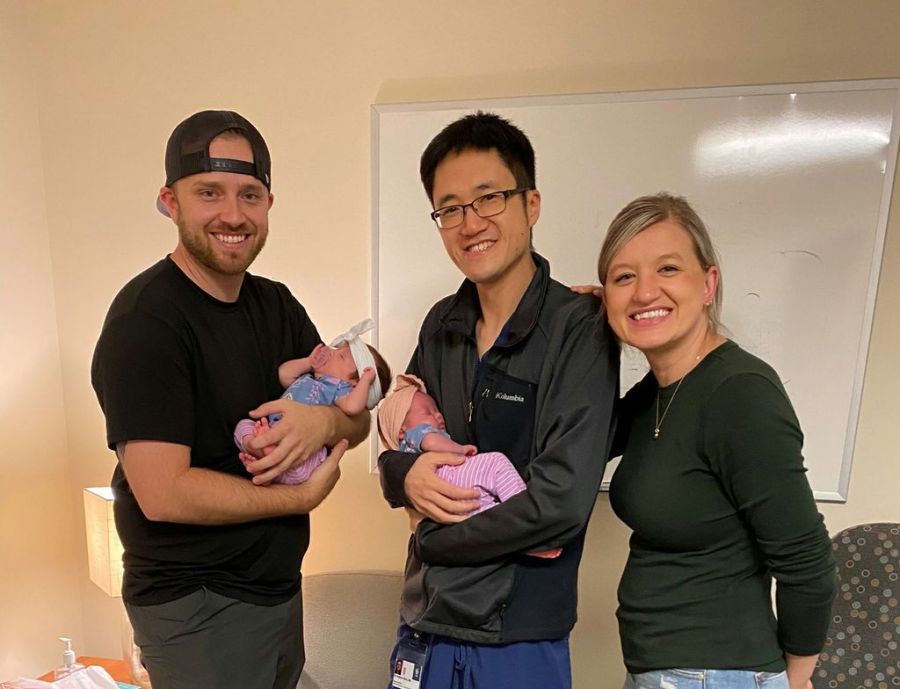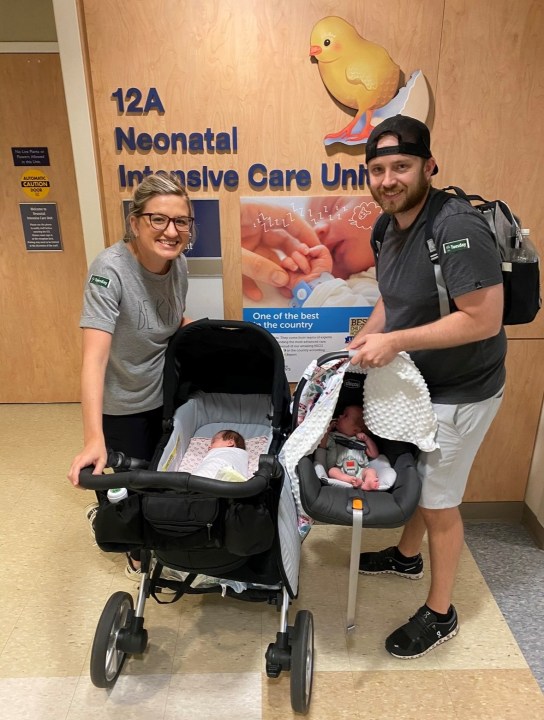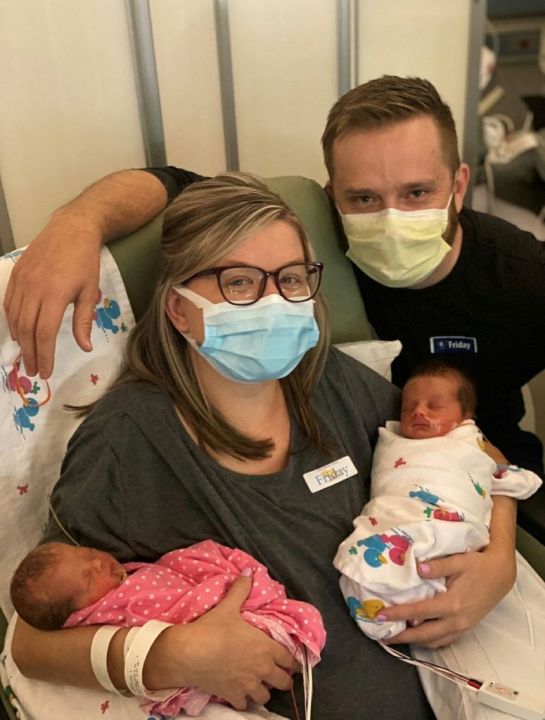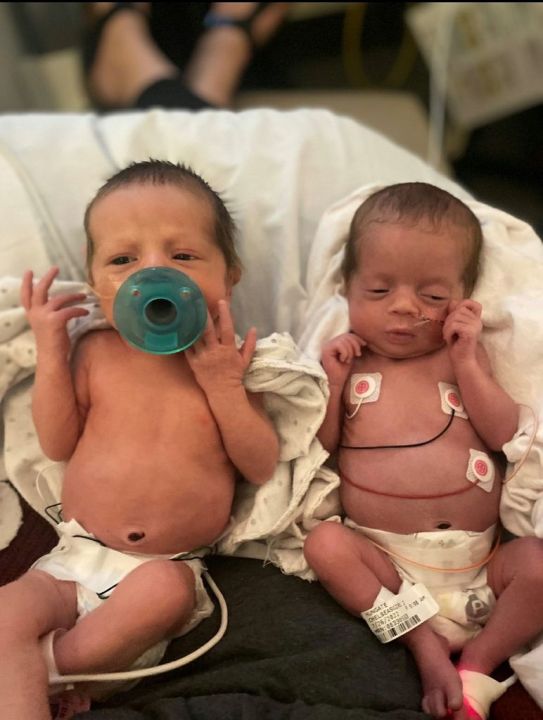PORTLAND, Ore. (KOIN) – Chelsea and Billy Hungate are the proud parents of twin baby girls. The girls have been healthy and growing since they were born in the summer, but if one of them hadn’t received surgery before she was born, things might have gone very differently.
For more than two years, the Hungates had been trying to get pregnant. Chelsea underwent procedures and tried various fertility treatments before she finally became pregnant in late 2021.
The pregnancy felt like a miracle, the couple said. Chelsea had been on Clomid, a medication that stimulates ovulation, and her doctor told her that if she didn’t get pregnant within a small window of time, the couple would be forced to rely on in vitro fertilization to get pregnant.
Billy is a pastor and the Clackamas couple is strong in their faith. Even though their chances of pregnancy were slim, they trusted the recommended process would work.
When they had the opportunity for a doctor to perform intrauterine insemination to help them get pregnant, the doctor told them their possibility of success was less than 10%. That didn’t stop the Hungates from going through with it.
“Something went off in my head that was just like, hey, God is bigger than any of these numbers that this lady’s giving you. And so, I was like, I called [Billy] back there to talk about it and I was like let’s do this,” Chelsea said.
About two months later, a blood test confirmed Chelsea was pregnant with twins. The couple celebrated, told their family members and started going to their regular checkups every three weeks.
The two girls, whom they referred to as Baby A and Baby B while they were still in the womb, seemed to be doing fine – until Chelsea’s 30-week appointment.
The sonographer had been carrying on conversation as normal while examining Baby A during an ultrasound. When she turned her attention to Baby B, her demeanor changed. The conversation stopped and she started measuring things she hadn’t measured before.
Dr. Jason Naoki Hashima, who works with high-risk pregnancies at Kaiser Permanente, came into the room and told the Hungates they were seeing something concerning with Baby B. He briefly mentioned it could be hydrops and told them they should go to OHSU for more imaging right away.
“The way that everything was handled was so calm that we were thinking there’s no way there’s something, like, life-threatening or anything because they’re so calm and just really comforting,” Chelsea remembered.
When they arrived at OHSU, the Hungates soon learned the situation was serious. Hydrops is when large amounts of fluid build up in a baby’s tissues and organs. It is life-threatening to a developing baby if it’s not treated quickly.
The Hungates were explained their options and were read their rights about terminating the pregnancy. They had the option to end the pregnancy for both babies or one of the babies, with the hope the other doesn’t develop hydrops. They could also do nothing and there was a chance the baby with hydrops could die within a couple of days.
Dr. Andrew Chon, a specialized fetal surgeon at OHSU, presented them with another option. He said he and another doctor, Dr. Raphael Sun, could perform an in-utero surgery (a surgery inside the uterus) where they place a shunt in the unborn baby’s chest.

Chon and Sun had been recruited to help establish a fetal care program at OHSU’s Doernbecher Children’s Hospital at around the same time in 2021. The program allows doctors to perform the full spectrum of fetal surgery and provide both prenatal and postnatal services all on one campus. It’s one of only five facilities that offer all these services in the U.S.
Before seeing Chelsea, Chon and Sun had done a few intrauterine transfusions and shunt placements for other fetal patients, but they knew the risk was greater in this case because Chelsea was pregnant with twins.
“The risks of the procedure can include things such as infection, bleeding, or breaking the bag of water so therefore, those complications have potential sequelae implications to the other co-twin,” Chon explained.
“It really takes a lot of precision in terms of ultrasound and ultrasound guidance,” Sun said. “It takes just this accuracy and millimeters, we’re talking about millimeters, of being able to deploy a successful shunt.”
By placing a shunt in the fetus’ chest, it allows the excess lung fluid to drain out and eliminate the hydrops.
Even with the risks, the Hungates thought the surgery sounded like their best option and decided to move forward with it.
Chon and Sun performed it the following day.
Afterward, Hungate said she felt better than she had in weeks. They’d drained 3.5 liters of fluid off her, which brought her a lot of relief. She said the incisions from the surgery were so small they didn’t bother her.
Chelsea continued appointments with Chon every 48 hours for the next few weeks. At 33 weeks, the doctor discovered the shunt had dislodged and asked the Hungates to make another decision.
“He said, ‘OK, Chels, you could deliver. We could do this, or we could go back in and place another shunt and potentially give the babies more time to cook. What are you thinking?’ And any time that option was there, we’re like, ‘More time! More time!'” Chelsea said.
Billy said this felt like a safe decision because an emergency C-section was always an option.
The doctors performed another surgery and this time placed shunts on both sides of the baby’s chest.
These shunts held and Hungate successfully delivered the twins at 34 weeks and 3 days.
The girls were named Adalee and Ayla. Ayla was the baby who had hydrops.
“When the NICU doctor said this is a 34-and-3-week hydropic-resolved baby, my husband and I cried. That was the first time we’d ever heard that and I couldn’t even comprehend things anymore after hearing that, just having that assurance that everything’s OK,” Chelsea said.
She and the babies received postpartum care at OHSU. Chon said all things considered, this was a favorable outcome.
Ayla’s shunts will need to come out eventually. If fluid is still collecting in her chest, doctors can use a chest tube to remove it, but Sun said in most cases of babies who had hydrops, the fluid resolves.
“From what I remember, by the time we saw them in the NICU, which was several weeks afterwards, they were doing really well and there was no chest tube in place,” Sun said.
The doctors expect Ayla’s health to be fairly comparable to her twin’s. They don’t expect any major complications from the hydrops.
The Hungates have sent Chon and Sun pictures of the girls since they left the NICU. The twins are doing great at home and the family is preparing for Christmas. This year, they feel like they received an extra special gift.
Chon and Sun hope the new fetal care program at OHSU’s Doernbecher Children’s Hospital will help create more successful outcomes for families like the Hungates.




